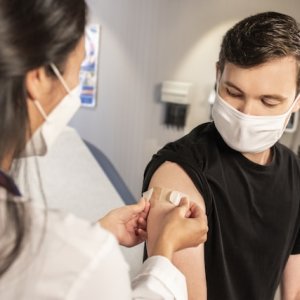
The Ghosts of HealthCare Past, Present and Future
When President Enrique Peña Nieto took office almost six years ago, he promised to work toward universal healthcare, an elusive goal the Mexican health sector has been chasing for years. As President-elect Andrés Manuel López Obrador prepares to take office, challenges old and new await.
The responsibilities of Mexico’s Ministry of Health are substantial. The institution must look after the health of 127 million individuals while leading all national policy on healthcare matters, coordinating institutions within the National Health Service and managing all healthcare infrastructure, among many other tasks. Even though the ministry has a lot on its plate, its current vision goes even further, with an ultimate objective to implement a universal healthcare system that provides equal, sustainable and integral attention to all individuals, placing special attention on vulnerable groups.
Mercedes Juan López, who was appointed Minister of Health by Peña Nieto in December 2012, set this as her main goal when she was named to the position. “Peña Nieto asks that all Mexicans and medical professionals commit to making effective the right to healthcare protection,” Juan said during her inauguration speech. This was necessary “to achieve an inclusive Mexico without poverty through the consolidation and creation of effective programs that lead to development and equality in the country.” Juan stated that her administration would work toward providing all Mexicans access to basic and specialty care, including surgeries.
When delineating the strategy to achieve this goal, Juan mentioned the challenges of overcoming Mexico’s changing epidemiological profile caused by an aging population and unhealthy habits, such as bad nutrition and lack of physical activity. Other risk factors she identified were unsafe sex, tobacco, alcohol and illegal drugs consumption and lack of road and workplace safety. Juan also identified three main problems that hindered the state’s ability to provide access to care. The first was the current model of healthcare, focused on curing diseases instead of preventing them. The second was the lack of implementation of multidisciplinary public policies that involve different institutions; to do so it would be necessary to guarantee an efficient coordination between state and federal strategies to ensure that healthcare permeated the action plans of other sectors. Finally, the third challenge was the unequal benefits and the participation of fragmented, vertically integrated institutions that, she said, went directly against the purposes of an inclusive country and prohibited the provision of continuous care through an individual’s entire life.
To address these challenges, Peña Nieto’s National Development Plan 2013-2018 included a set of six objectives for healthcare, clearly delineated in the Ministry of Health’s Sectorial Health Program 2013-2018. The first was to consolidate all actions related to health protection and health and disease prevention. The second was to guarantee access to quality healthcare services to all people. The third was to focus on reducing the infant mortality rate. The fourth was to close healthcare gaps across social groups. The fifth was to guarantee the efficient use of healthcare resources and the sixth was to work toward a National System of Universal Health led by the Ministry of Health. Within the Sectorial Health Program 2013-2018, Juan stated that this system would be achieved by strengthening regulators and the cooperation among different sectors. This system, she added, would also focus on providing services based on primary care, generating and managing appropriate budgets and promoting scientific research.
These goals were ambitious at the time and they continue to be so despite the progress made on several fronts. Among the Peña Nieto administration’s achievements were strengthening COFEPRIS, Mexico’s regulatory authority for medications, medical devices, foodstuffs and cosmetics, among many other products. This council helped increase access to care through the approval of 540 generic versions of previously- patented medicines, which allowed the reduction of up to 70 percent in the price of drugs. Moreover, healthcare penetration expanded during that time. While in 2012 only 78.6 percent of the population had health coverage from a public healthcare institution, by 2016 almost 86.6 percent of the population was affiliated to a system such as IMSS, ISSSTE or Seguro Popular, according to ENSANUT 2016.
NARRO TAKES THE HELM
Juan left the Ministry of Health in 2016 and was replaced by José Narro, a surgeon from UNAM with a master’s in communitarian medicine from the University of Birmingham and who continued her legacy. While coordinating the Joint Session with the National School of Medicine in 2018, Narro named as some of the main achievements of the administration the reduction of HIV transmission from mother to child by 40 percent, maternal mortality by 13 percent and dengue by 70 percent between 2012 and 2018. Other achievements, he said, included the introduction of the HPV vaccine to protect girls from cervical cancer. “This country has been lucky with public policy in several programs, otherwise we would not have been able to achieve what we have. A clear example is vaccination. For over 40 years we have been dedicated to vaccinating the population. There is no rubella or congenital rubella in Mexico, we have controlled diphtheria and tetanus and neonatal tetanus has been eliminated,” Narro told Mexico Health Review 2017.
During his years in office, Narro prioritized fighting chronic diseases as the way to improve care. “Diabetes is one of our highest priorities, but it is difficult to tell which is the most important because there are many, such as cancer and heart disease. When speaking of priorities, I often speak of diabetes because it generates the most deaths as a single cause. Cardiovascular disease may cause more deaths when grouped together but the causes are many and can be split into three main groups: heart attacks, hypertension and others,” said Narro.
Although the Ministry of Health made several significant contributions to improve quality of life and life expectancy during Peña Nieto’s time in office, the administration left several areas that will be addressed during López Obrador’s presidency. “Peña Nieto’s administration has driven the creation of a universal health system. We now need to sit down with IMSS and ISSSTE and figure out a common tab that will allow us to easily exchange services and allow affiliates of Seguro Popular to go to IMSS or ISSSTE facilities,” says Antonio Chemor, National Commissioner of Seguro Popular.
Furthermore, the rate of diabetes, chronic diseases and obesity continues to rise while the sector has also had to deal with a smaller healthcare budget that made Mexico one of the lowest investors in healthcare in the OECD. On Aug. 9, a day after López Obrador was officially named President-elect, Narro called for the future government to increase its healthcare expenditure and to tackle obesity-related diseases. Speaking at the LV Ophthalmology Actualization Course in Mexico City, Narro was frank: “We have a very serious problem,” he said.
















